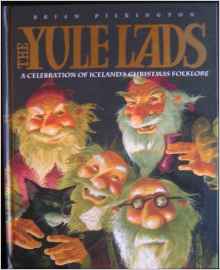In most Christian countries, Christmas was slower to catch on than other major church holidays. The clergy may have been wary of pagan solstice celebrations which happened at the same time of year and included serious revelry. Some early Christmas festivities mimicked the custom. They were banned in 17th century England, and American Puritans outlawed them too.
According to Brian Pilkington, author of The Yule Lads, Iceland was ahead of the curve. A 16th century law stated that “All disorderly and scandalous entertainment at Christmas and other times and Shrovetide revels are strongly forbidden on pain of serious punishment.”
Icelandic winters are long and dark, with fewer than five hours of daylight at this time of the year. Imagination tends to fill the darkness with what we fear, and Pilkington’s book describes “the lads” that kept Icelandic children awake at night. The gentlemen pictured on the cover are not our shopping mall Santas!
The matriarch of the clan was the ogress, Gryla, who loved to eat stewed children. It couldn’t be just any kid though. It had to be one who was “naughty, lazy, or rude.” In one 13th century account, Gryla had 15 tails, and tied to each was a sack full of naughty children. It was not “the most wonderful time of the year” if you were young! The Icelandic word for icicle is “grylukerti” which means “Gryla’s candle.”
Gryla had three husbands and 80 children, though legend now boils it down to 13 sons who visit the homes of children on successive nights from Dec. 12 – 25. Time and the law have taken the edge off the Yule Lads, for a 1746 decree said “The foolish custom, which has been practiced here and there about the country, of scaring children with Yuletide lads or ghosts, shall be abolished.” By the 19th century, the Lads had morphed from cannibals into rascals and petty thieves, who even began to leave gifts for good children who left their shoes on a window ledge.
The first to arrive was Stekkjarstaur, the “Sheep Worrier.” He would visit the the sheep cot and try to suck milk from the ewes. That doesn’t work in December and led author, Brian Pilkington to suggest that Sheep Worrier’s IQ is “somewhat less than three digits.” These days he heads for the fridge to get his milk. If a child has been good, Stekkjarstaur leaves a sugary sweet. Bad children get a potato.
Next comes Giljagaur, aka, “Gully Gawk” who travels through gullies and ravines, also in search of milk, but he looks for cow barns and inattentive milkmaids. “Stubby” arrives the third night, as short as his name suggests. He likes to raid the kitchen, as do the brothers that follow, “Spoon Licker,” “Pot Licker,” and “Bowl Licker.” In their present forms all they do is mischief, but food thieves were no joke in earlier times. For northern farming families, the time between Christmas and the spring thaw in April or May could be times of famine if food or fodder for livestock ran short.
The next lad to show up is Hurdaskellir, or “Door Slammer,” one of only two of Gryla’s sons who isn’t out to fill his belly. Imagine loud bangs in the dead of night and you know how he gets his jollies.

And as if the sons of Gryla were not bad enough, children also had to contend with Jólakötturinn, the Yule Cat, a huge feral creature who hunts children on Christmas Eve instead of mice. Like the lads, the cat discriminates in choosing his victims, eating only those who have not received a new item of clothing for Christmas. Pilkington says that “Until fairly recently in Iceland, all clothing came directly from sheep. The wool had to be washed, combed, and spun before it was painstakingly crafted into a garment. It was a long, arduous process.” Fear of the Cat induced lazy children to do their part!
This is a fun book and a fine counterbalance to the usual TV holiday movies. You can picture families gathered around the fire as the wind howls outside, thinking as we do when hearing a good ghost story, “This can’t be true…can it?” Something within the listeners then and within us now loves to be scared, to confront monsters and vanquish them in imagination. On that score, Gryla & Sons and the Yule Cat satisfy!
A click on the book cover at the top of this post will take you a site where you can order The Yule Lads.



Wow. I’ll bet kids in those times behaved pretty well. Scary stuff! I think I’ll get this for my grandchildren. That ought to keep them in line. I love the cover and I love hearing about these old tales. Thanks, Morgan, for another great post.
LikeLike
If you like the cover, you’ll love the illustrations, which are superb. And yes, if an 18th c. legislature had to act to tone down the stories told to kids, they must have been pretty well behaved…
LikeLike
This is so cool. I love the concept of the yule cat! Also, I want to wish you a great new year ahead. Cheers!
LikeLike
Pingback: The Taming of Jólakötturinn, Iceland’s Ferocious ‘Yule Cat’: From Blood and Gore to Peace and Goodwill - Head Magazine
Pingback: Yule & How to Celebrate it: A Pagan History of Christmas – Adventures of A Mage In Miami
Pingback: The Last Random Links Of The Year – Adventures of A Mage In Miami